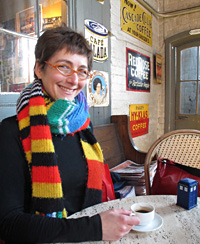I've had some terrific feedback in response to my last few posts - thanks! I'm glad people are finding the training socks helpful.
I promised that I would also tackle the topic of sock sizing... I'm going to divide this up into two: sizing as it relates existing sock patterns, and how to customize.
This will not be news to people who know me well, or have had a sock knitting class with me, but it's true: I have small feet. I wear a US women's size 6 shoe. Now, these feet of mine aren't extremely small; I can still easily find shoes to fit, but they are small enough that sock sizing becomes an issue.
Also well-known about me and just as true: I get very cranky about sock patterns that come in one-size-fits-all. Because it's just not true. One size does not fit all. I've got narrow size 6 feet; a good friend of mine has wide size 11 feet. The idea that the same sock would fit us both equally well is silly: there's a good 20% different in both foot length and circumference between my feet and my friend's. Yes, that's right: 20%. Put into terms that are easy to visualize, that's like expecting the same swimsuit to fit a size 4 and a size 12 equally well. Sure, the fabric stretches, but it won't be comfortable.
So when knitters are asking me for sock pattern recommendations, I tend to point them to sock patterns that come in multiple sizes.
And how to choose which sock size to knit? The first socks I knitted were all too big for me - by the end of the day they had stretched out and would fall off.
The thing is that wool and wool-based sock yarns (which most of them are) have natural elasticity (up to 25% or even more, depending on the breed of sheep!), and with the heat and moisture of your feet, your socks stretch out during the day. To ensure they stay up and on, they need to be made with negative ease. That is, the socks should be smaller than you - about 10 to 15%. Your socks should start the day a little tight - not circulation-constrictingly tight, but snug - so that when they stretch out, they stay on. Think about your commercially-bought socks - they all stretch to fit.
So when choosing a sock pattern, if you're choosing a pattern sized by finished measurements (which I think is a very helpful idea, are you listening, designers?), choose a size that's about 10-15% smaller than your actual ankle/foot circumference. For an adult sock, that's about an inch/2.5cm smaller.
And the same thing applies to foot length, too... I always knit my socks about a quarter to half an inch (a cm) shorter than foot length.
And after a long day of wearing socks, they're still comfortable and they stay on when I take my boots off!
Subscribe to:
Post Comments (Atom)






3 comments:
Hi Kate! I use your top down pattern all the time. This concept of negative ease is pretty revolutionary to me. Does this mean I should be subtracting 10-15% from the pattern (e.g. # cast on stitches, length of foot),or is negative ease already accounted for in the formula? Thanks!
Your blog is so helpful. Thank you so much! I always learn something and these past two sock posts have been terrific! Thank you!
Thanks so much! I've knitted for a couple of years now -- and have finally knitted a recognizable sock ( her name is "Footloose." Now I'm ready to try & make a pair that fit. You have been very informative. Thanks again
Norma (broomgrass@gmail.com)
Post a Comment